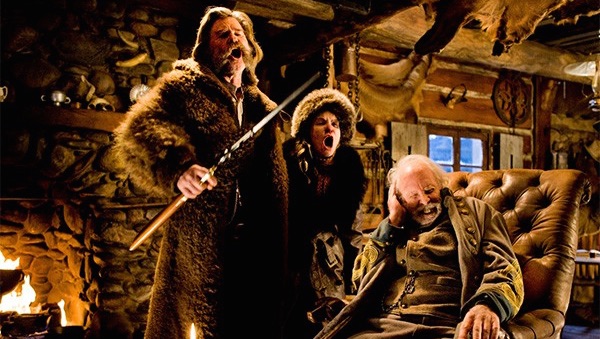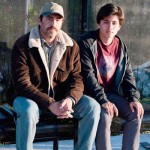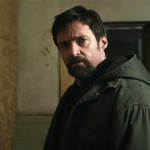The Hateful Eight Review
There was some blood spilled at a Wyoming haberdashery some time after the Civil War. Well, a fictional Wyoming haberdashery, but still … boy, there was some blood.
It’s the time and place of Quentin Tarantino’s eighth film, the very appropriately titled The Hateful Eight. The blood is nothing new in a Tarantino flick, but its use is somewhat novel for the writer-director. There’s a rage in this film that physically manifests itself as red blood all over its walls, its floors, its clothing, and most notably, its characters’ faces. Why are they all so rage-filled? Well, they’re hateful, racist, sexist, homophobic, straight-up despicable bastards, and they’re in the company of a murderous woman who’s nastier, scarier, and angrier than the lot of the men.
Tarantino, too, is mad as hell. The Hateful Eight is of a very specific time and place, but certain themes are very much of our current time and place. Even an exaggerated film like this shows us that when it comes to race relations, we’ve made remarkably little progress in 150 years. And if you want to talk about guns, so does Tarantino. This is the distrusting society we could have if the NRA got its way.
It’s this — among so many other qualities — that make The Hateful Eight an anomaly within Tarantino’s crackling filmography. It’s this — among so many other qualities — that make it one of my favorite Tarantino movies.
He brings us into this world with a long, simple take of a difficult-to-define shape somewhere in the snow. As Ennio Morricone’s deep, tense, eerie score plays, the camera zooms out to show us two things. In the distance, a stagecoach is approaching, and that mysterious shape? It’s a very foreboding, somewhat deformed wooden cross.
The stagecoach is carrying two: the bounty hunter John “Hangman” Ruth (Kurt Russell) and his latest bounty, Daisy Domergue (Jennifer Jason Leigh), a murderer worth $10,000 in the town of Red Rock. Along the way, Ruth is persuaded to pick up two more passengers, saving their lives from a brutal blizzard in the process. One is a fellow bounty hunter, Major Marquis Warren (Samuel L. Jackson), who gained notoriety (and a long-distance friendship with one President Abraham Lincoln) by killing scores of rebels during the just-ended Civil War. The other is Chris Mannix (Walton Goggins), the new sheriff of Red Rock and the son of a famous Confederate hero.
The blizzard forces them to break at Minnie’s Haberdashery, where they encounter four others. Oswaldo Mobray (Tim Roth) is the new hangman in Red Rock, meaning he and Mannix are about to become business partners of sorts. Joe Gage (Michael Madsen) is on his way home to visit his mother for Christmas. General Sandy Smithers (Bruce Dern) is another Confederate hero who’s in Wyoming to find out what happened to his dead son. And Bob (Demián Bichir) is in charge of the place as the regular proprietors, Minnie and Sweet Dave, are visiting family.
As their night together unfolds, the party of eight separates into those aligned with the Union cause and those closer to the Confederacy. Warren, obviously, is part of the former, as is Ruth, who tells his compatriots that someone in the room is not who they say he is, and that person is willing to do anything to see Daisy Domergue walk free.
We have reason to suspect everyone and, at the same time, no one. Ruth is one man who offers no proof for his declaration, yet it seems conceivable that everyone of these bastards is a thief, liar, or worse. That’s both the beauty and the horror in the world Tarantino has created — filmed in exquisite 70-millimeter film. What’s more, they’re all heavily armed, and many carry deep-seeded hatred for others in the party. The decision to use antiquated technology to capture the film’s mostly interior setting is a curious one on the surface, though within the context of the film, it makes perfect sense. Not only do Tarantino and cinematographer Robert Richardson use the most expressive lighting possible to direct our attention around the expansive frame, the technique also lends the setting a greater breadth and depth, which Tarantino uses thematically: separating “the North” from “the South” and preventing the film from ever feeling claustrophobic.
While the plot hinges on his mystery, however, the film doesn’t. It’s arguably the least important thing on the screen, and Tarantino laughs it off as ridiculous (not unlike he does with the film’s violence against women and intensely racist language). That’s sort of the point. The Hateful Eight, its characters, and its story are so deeply unpleasant that they border on satirical. It allows the viewer to search for deeper meaning, which it has in spades, while laughing at the absurdity and excess when our search for a hero ends.
It’s impossible to discuss The Hateful Eight without bringing up its outstanding cast. Jennifer Jason Leigh was the only member of the cast formally recognized, and she’s wonderful. The character — really none of them, though it works in the film’s favor inexplicably — isn’t particularly three-dimensional, but Leigh is patient and rolls smartly with the film’s, er, punches. We’re constantly told what an evil woman she is, and we’ll see it, but for some time, she’s a nasty lady whose punishment doesn’t appear to fit any crime. It’s interesting work in an interesting film.
Among the rest of the Eight, Samuel L. Jackson and Walton Goggins stand out most. Tim Roth appears to be filling in for Christoph Waltz (though it’s still quite nice to see the actor reunite with his Reservoir Dogs co-star considering how much this film resembles that one), while Michael Madsen doesn’t seem to be on the same planet as the rest of the cast.
I understand the criticisms leveled at the film, but I think many of its critics probably gave up on it too soon. The first time Daisy’s nose gets bloodied up will be an inflection point for many viewers. You’ll either check out ten minutes in, or squirm uncomfortably and wait to understand what exactly this is all about. The former viewers will miss out on a chance to intellectually engage with something dark but rewarding, while the latter viewers ought to respond strongly to the most open-ended, pointed, and relevant movie of Tarantino’s career.
















One Response to The Hateful Eight Review